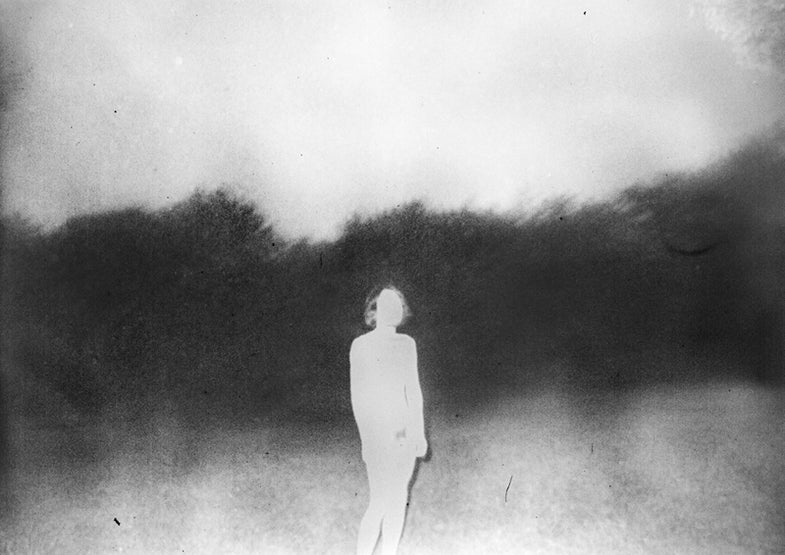Shoot, Print, Repeat: An Interview With Daisuke Yokota
When I met Daisuke Yokota for our interview in Tokyo’s Shinjuku district, he said it was the earliest he’d been...











When I met Daisuke Yokota for our interview in Tokyo’s Shinjuku district, he said it was the earliest he’d been up in a while. It was already about 11:45 in the morning, and I wondered aloud whether he’d been working a late-night job. “Nope,” he said. “Making work.” Yokota has created a small image-making factory in his apartment, which he uses to create his haunting, distorted black-and-white images. Many Japanese photographers, led by Daido Moriyama, take black-and-white photographs with similarly strong, almost extreme contrast. At first glance, Yokota’s photographs seem to fit neatly into this tradition. However, in talking with him, it’s clear that he hasn’t set out to copy this style because it looks cool. Instead, he’s been led there by electronic musicians like Aphex Twin, taking the musical ideas of echo, delay and reverb and applying them to photography. In practice, this means that to make the series “Back Yard” (featured in the gallery above), Yokota shot, developed, printed and re-photographed each image—not once, but about 10 times. That does seem like enough work to keep you up all through the night.
How did you make “Back Yard”?
At first I used a compact digital camera, and printed the image out. Then I photographed that image with a 6×7 film camera, using color film, even though the image is later black and white. I developed it at home, in a way so that imperfections or noise will appear—I make the water extra warm, or don’t agitate the film. Even before that, I let some light hit the film; I’m developing in my bathroom, so it’s not even a real darkroom, which helps, but I’ll hold a lighter up to the film, or whatever is around. I’m always experimenting—the goal is to not do it the same way twice. So then, to produce more and more variations in the final image, I re-photographed the image about ten times.
Ten times? You mean, you developed and printed and re-shot each image ten times?
Yeah, more or less. There’s no set number, but about that much. It’s not so much about realizing an image I had in my head from before, but finding something in the process. “Back Yard” was pretty simple, just that. “Site” was more complicated—taking digital photos of the same thing and combining them in Photoshop—that took a lot of time.
And re-photographing photos doesn’t take so much time?
I guess so, yeah.
Photoshop is not really about adding the noise then?
Doing that in Photoshop makes it look tampered with. Adding the noise with film, it looks natural.
In some of your other interviews, I see you’ve mentioned Aphex Twin and David Lynch as influences. Why is that?
There are two reasons. First, Aphex Twin has a lot of aliases, so his work is less about seeing his real name as some kind of symbol, and more about the songs themselves. There’s a sense that you can’t really see him, and this kind of confusion is interesting to me. Then, to speak about his music, there’s a lot of experimentation with delay, reverb and echo, which is playing with the way that you perceive time. Of course there’s no time in a photograph, but I thought about how to apply this kind of effect, or filter, to photography. I was definitely influenced by the idea of “ambience.” David Lynch is probably the same for me, in the way that he works with time and perception.
So how does all of this apply to your photographs?
If you look at music or film, there is time there. In other words, the work has a clear beginning and end, and in between, you shut out your daily life—you throw yourself into the work. There’s no element of duration to your experience of a photograph; it’s closer to an object. I felt that this was an extremely weak point of photography. So, I’m aware that photography can’t function in the same way as films or music, but I wonder whether it isn’t possible to create a way for photographs to carry time within them. When you’re going to sleep, you think about the stuff that happened to you that day, right? You might see some images, but they’re completely distant from what really happened—they’re hazy. You’re trying to recall something, and photography can also recall things in this way. Of course my photographs do function as some sort of record, but there’s no agreement between the photograph and my own recollection of what happened. The impression is completely different. I think using these effects of delay, reverb, and echo (in photographic terms, developing the film “badly” and so on) might be a way to alter the sensation of time in a visual way.
This interview was translated from Japanese. Daisuke Yokota has self-published a photocopied zine version of “Back Yard.”